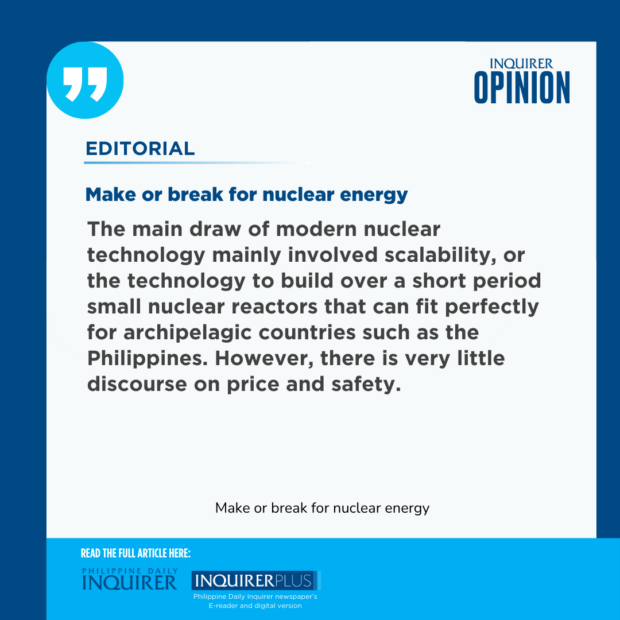Make or break for nuclear energy

I believe it is time to reexamine our strategy towards building nuclear power plants in the Philippines,” President Marcos said in his first State of the Nation Address (Sona) in 2022. “There have been new technologies developed that allow smaller scale modular nuclear plants and other derivations thereof.” Since then, a lot has happened in the country’s nuclear energy space.
Former president Rodrigo Duterte had earlier moved to reintroduce nuclear energy in the country’s power mix, which to date is still largely based on coal. A 2019 agreement between Russian State Nuclear Energy Corp. and the Department of Energy (DOE) did not push through following Russia’s invasion of Ukraine in 2022, prompting a shift in the Philippines’ strategy.
In his Sona in 2022, Mr. Marcos noted that the Philippines will comply instead with the International Atomic Energy Agency safety regulations for nuclear power plants “as they have been strengthened after Fukushima,” referring to the major accident at the Fukushima Daiichi nuclear power plant in Japan in March 2011 that followed a strong earthquake and the tsunami it generated.
Mr. Marcos does not expect nuclear energy to be operational within his term that ends in 2028, with the Philippine energy plan targeting to have 1,200 megawatts (MW) of the zero-emission power source by 2032. He is just setting the groundwork on how to move nuclear use forward.
Big leap
His bid for a nuclear future for the Philippines took a big leap in November last year on the sidelines of an Asia-Pacific Economic Cooperation (Apec) summit in San Francisco, California, when the so-called “123 agreement” was signed between Manila and Washington. The landmark nuclear cooperation agreement, which governs the “safe and secure use of nuclear energy for peaceful purposes” and a requirement before American companies can invest in nuclear energy in foreign countries, came into force on July 2 this year.
In May this year, on the sidelines of a high-level Indo-Pacific Business Forum, Energy Secretary Raphael Lotilla and US Agency for International Development-Philippines mission director Ryan Washburn signed an agreement to train Filipinos on how to build and operate nuclear plants for civilian use through scholarships and academic exchanges. The US Embassy in Manila also formed in the same month the US Civil Nuclear Industry Working Group for Southeast Asia, which will gather American companies looking to bring their technologies to the Philippines. The following month, the DOE created a division tasked to promote, formulate, and implement plans and programs to advance the use of nuclear energy in the country.
Safety concerns
Last week, the Philippines and South Korea signed an agreement on the conduct of a feasibility study to revive the mothballed Bataan nuclear power plant (BNPP) as part of government efforts to boost energy security in the Philippines. The controversial $2.3-billion project, which began construction in 1976 during the time of the President’s late father, was never operated due to safety concerns and allegations of corruption.
The DOE also announced that the government will hold the Philippine International Nuclear Supply Chain Forum 2024 on Nov. 13-15. It will gather players from the United States, Canada, France, Japan, and South Korea to share their best practices in the deployment of nuclear energy.
It is hoped that in the coming forum, the government and the private sector players will discuss what has been missing in current discussions on civil nuclear use, an issue that has hobbled past efforts in this direction. The main draw of modern nuclear technology mainly involved scalability, or the technology to build over a short period small nuclear reactors that can fit perfectly for archipelagic countries such as the Philippines.
‘Social acceptance’
However, there is very little discourse on price and safety. Aboitiz Power Corp., which is among the first few conglomerates to express interest in going nuclear, emphasized these two priorities in going nuclear. “Number one, nuclear energy has to be safe, full stop. At the same time, it has to be reliable and affordable,” said AboitizPower head of energy transition projects Felino Bernardo.
It will, no doubt, be just a matter of time before the problem of obtaining “social acceptance” sets in, similar to what happened to the BNPP. Businessman Sabin Aboitiz, president and CEO of the Aboitiz Group and head of the team of economic advisers to the President very clearly pointed out what can make or break the push for nuclear energy in the Philippines.
In his report on the outcomes of the virtual roundtable discussion on nuclear energy held in October 2023 among business leaders from 21 Apec economies, he concluded that the future of nuclear power hinges on the “public’s acceptance and understanding,” and that building trust and guaranteeing safety and responsibility in the use of nuclear energy are of paramount concern.




















